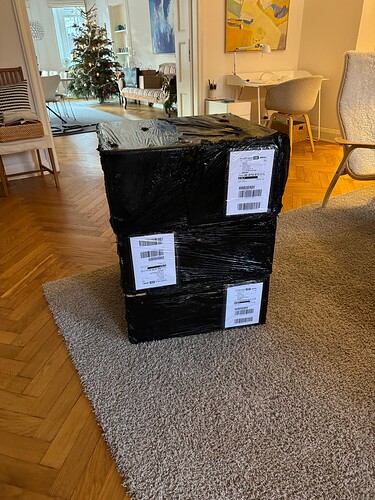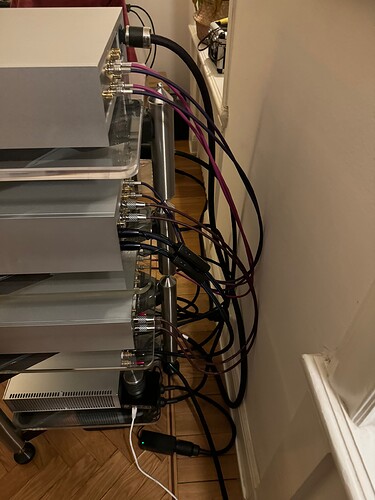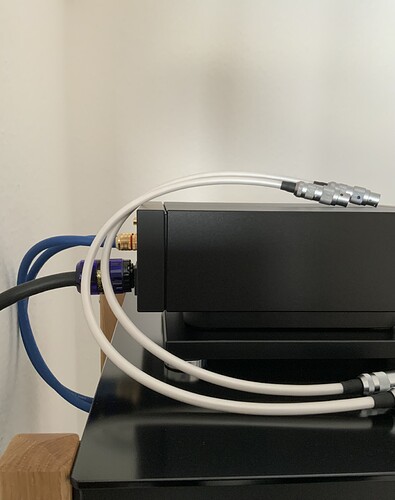A great sentiment. Enjoy every step of the journey wherever it leads.
I was in hospital for an operation on my shoulder yesterday (all good) so slept quite poorly as a result of the discomfort and the anaesthetic. Very weird dream, different to the last two nights. This time my display looked like this.
Seems @chrisk was closer than I realised, I was dreaming about a Vivaldi. Chris, you get this month’s golden struts award and may use this image on your avatar with my blessing for 30 days. Congratulations!
You are now the official the dCS dream-shrink! ![]()
So, when I got back from hospital I started to realise it might not have been a dream after all. Santa had apparently made a late delivery…
And all was not as it first seemed…
So after a few hours of futzing I have a new view from the listening chair…
@ChrisK, you are clairvoyant! ![]()
![]()
So, now I have plenty to keep me occupied through my convalescence. I am still not 100% certain I have the clock cables connected correctly or configured the upsampler settings the way I want them, but now the fun starts. Woohoo!
The snake pit…
Must say, there is an awful lot to be said for the Bartók one-box! dCS (@Phil, @James) please replace all this with fiber umbilicals in the next generation ![]() . This is bananas!
. This is bananas! ![]()
OK, I think I have connected the clock cables correctly at the third time of asking. This is not exactly intuitive…
If the clock cables are incorrect you should see a red warning on the DAC ( “Bad clock” - see page 29 of the user manual).
Hope your shoulder recovery goes well. My friend had both of her shoulders done at the same time and that was really disabling. I’m awaiting an in-patient appointment myself for other issues but that will hopefully be overnight only.
Thanks Pete. And you probably noticed that I heeded your advice and ordered colour-coded clock cables. Good call, thanks for the heads up!
I had an ORIF on my left shoulder in 2007. Large metal plate and hardware in there. Can’t begin to describe the pain involved at the time and the resulting constant discomfort and limited ROM. Broke the wrist on the same arm a couple of years afterwards ![]()
Mrs D dreads ‘the call’ from A&E so I’ve stopped being silly these days.
Do. The. Physio.
Anyways back to the thread topic.
No short pants for you anymore, this is big boy territory! Good luck with the shoulder recovery.
Thanks Mark. Wise words, message received and understood. ![]()
Well I have now read the manuals cover-to-cover, checked and re-checked the clock cables and adjusted all the settings according with all the insights and advice I have read over the last three weeks on this forum. I have just cued up the 24/192 version of Kind of Blue and am playing So What upsampled to DXD with F5 and M3.
And all I can say is wow! ![]()
This is a whole new chapter for me. The bass, the soundstage, the everything! This is quite a shock. Will take a while to get my head around this. I have heard Vivaldi short stacks and Vivaldi tall stacks at shows many times. Even if I rule out all the times it has been playing Norah Jones, Patricia Barber or Diana Krall it must still be at least ten different occasions. But hearing it in my own system in my own room through the stunningly transparent Nord Three 1ET400A ST amp and my Serblin Ktêmas with the Mitchco V3 filter set is just something else. Just. Something. Else.
I am now starting to understand why the big boy club guys always have those massive smug grins on their faces! ![]()
I wonder how much the strikingly better SQ of the 6V output has to do with the transparency of the whole chain/system. I listened to Annie Lennox “A Whiter Shade of Pale” and the difference in her voice is huge between 2V and 6V. It’s as if something was wrong with the mic when they recorded the vocals. It’s actually unlistenable at 2V.
I completely agree (well, maybe not with the bit about 2V being “unlistenable” but I get your point!) Have the dCS folks ever commented this at all? I’ll have to have a look back through the threads and see…
Congratulations on your new acquisitions Struts!
Yes, that was exaggerated. The difference becomes more striking at higher volumes.
When people notice the sound change when switching output voltages - is that when using a preamp?
Going direct to amp shouldn’t make much of a difference because the same voltage is sent for a given SPL volume rewardless of what output voltage is selected. I don’t have a preamp and I use the output voltage as a high level volume control and fine tune with the normal volume control.
No Mark, I am driving my power amp directly and notice a very clear qualitative difference between 2V and 6V (to the advantage of the latter) at subjectively similar volume levels.
This despite the fact the input sensitivity of my amp suggests 2V would be a better match and that 6V means I am typically running between -45dB and -30dB of attenuation. In other words 6V would, according to conventional wisdom, appear to be a sub-optimal match and I am “throwing away” bits of resolution unnecessarily as well as risking driving my amp into clipping. But it sounds better!
The difference is, at least in my mind, way too obvious to be explained by a very small improvement in an already best-in-class SNR figure. It seems to point to some fairly substantial difference in the way the output stages (and I use the plural deliberately) are implemented. All output voltages appear not to have been created equal!
I am really curious to understand the explanation for this. Grateful for any insights @phil or @james can share with us.
I believe that it has to do with the transparency and the transient speed of the system/chain.
I have two pairs of XLR interconnects. The reason I’m keeping the Oyaide Tunami Terzo V2, which costs less than one tenth of the Cardas Clear Beyond, is because the slow transient speed and overhang of notes it creates work better for certain tracks where there is a simple melody accompanying vocals, “You Lost Me” by Christina Aguilera, “Foolish Games” by Jewel (the Kelly Clarkson version), “Duet” by Rachael Yamagata, etc. The vocals sound as if each note is exhaled into one’s ears with the Oyaide. I have a separate playlist just for this cable.
On the other hand, the vocals in “A Whiter Shade of Pale” by Annie Lennox and in “Careless Whisper” by Disco Gang the Acappela Version, sound a bit over the top at 6V with the Oyaide. Apparently the recordings of these two tracks do indeed require the more “refined, even-handed” sound that 2V puts out. And probably my whole Cardas Clear Beyond playlist also requires 2V with the Oyaide. I just checked “Put Your Lights On” on the Carlos Santana Supernatural album and “Lose Yourself” by Eminem. At 6V the bass is a bit boomy and the whole presentation sounds a bit “blurry” with the instruments not being clearly defined. At 2V everything sounds more coherent.
Enter the Cardas Clear Beyond interconnects. Every track with this cable on my playlist (the playlist for the Cardas makes up about 90% of my favorite tracks) sounds much better at 6V than at 2V, every single one. Everything sounds more natural and there is more detail while the bass is tight and the instruments are clearly delineated.
A small level of distortion isn’t always bad. Some music is recorded so clean or has attenuated highs that a small amount of distortion improves the sound. And some speakers & amps also reduce the highs and adding a tiny amount of distortion is an improvement. Is it possible that is what is happening in these cases?







